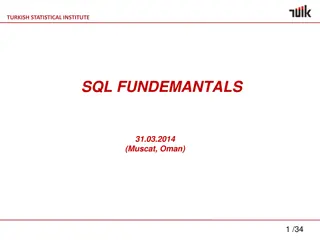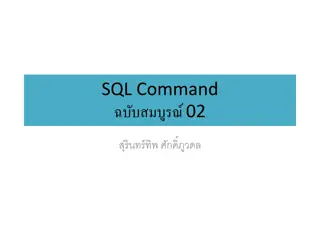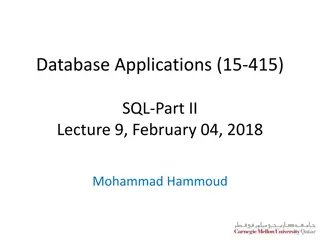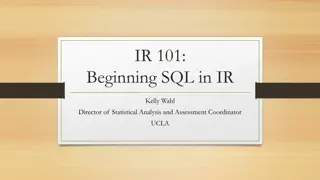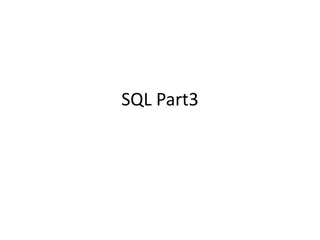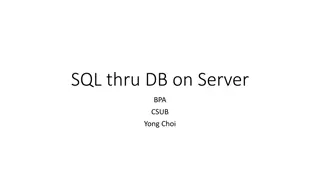Understanding SQL Joins in ASP.Net 2.0 with Visual Studio 2005
Exploring the importance of query joins in SQL, this instructional content delves into inner, outer, left outer, and right outer joins for integrating data from multiple database tables in ASP.Net 2.0. Detailed guidance is provided on setting up SQL databases in Visual Studio .NET 2005, creating tables, adding data, and executing join queries.
Download Presentation

Please find below an Image/Link to download the presentation.
The content on the website is provided AS IS for your information and personal use only. It may not be sold, licensed, or shared on other websites without obtaining consent from the author. Download presentation by click this link. If you encounter any issues during the download, it is possible that the publisher has removed the file from their server.
E N D
Presentation Transcript
SQL Query Joins ASP.Net 2.0 Visual Studio 2005 CSE686 Internet Programming Instructor: James W. Fawcett TA: Murat K. Gungor Summer 2006
Query Joins Why do we need query joins? View information from two or more separate database tables Type of query joins Inner Join Outer Join Left Outer Join Right Outer Join 2
Add new SQL Database File Let s Open Visual Studio .NET 2005 Using Sever Explorer Add Connection We just created BestShop.mdf (mdf =Master Database File) 3
Lets add two tables Customers and Orders CustomerID is Unique and it is an Identity ProducID is Unique and it is an Identity 4
We have CustomerTable and OrderTable Lets add some data to our tables 5
Inner Join An inner join is a join that selects only those records from both database tables that have matching values. Records with values in the joined field that do not appear in both of the database tables will be excluded from the query. SELECT CustomerTable.Name, OrderTable.ProductName FROM CustomerTable INNER JOIN OrderTable ON CustomerTable.CustomerID = OrderTable.CustomerID 6
Inner Join Query Result The INNER JOIN returns all rows from both tables where there is a match. If there are rows in CustomerTable that do not have matches in OrderTable, those rows will not be listed. We see ONLY matching values SELECT CustomerTable.Name, OrderTable.ProductName FROM CustomerTable INNER JOIN OrderTable ON CustomerTable.CustomerID = OrderTable.CustomerID 7
Outer Join An outer join selects all of the records from one database table and only those records in the second table that have matching values in the joined field. In a left outer join, the selected records will include all of the records in the first database table. In a right outer join, the selected records will include all records of the second database table. SYNTAX SELECT field1, field2, field3 FROM first_table LEFT JOIN second_table ON first_table.keyfield = second_table.foreign_keyfield 8
SELECT CustomerTable.Name, OrderTable.ProductName FROM CustomerTable LEFT OUTER JOIN OrderTable ON CustomerTable.CustomerID = OrderTable.CustomerID NULL values also appears The LEFT OUTER JOIN returns all the rows from the first table (CustomerTable), even if there are no matches in the second table (OrderTable). If there are rows in CustomerTable that do not have matches in OrderTable, those rows also will be listed. 9
SELECT CustomerTable.Name, OrderTable.ProductName FROM CustomerTable RIGHT OUTER JOIN OrderTable ON CustomerTable.CustomerID = OrderTable.CustomerID The RIGHT OUTER JOIN returns all the rows from the second table (OrderTable), even if there are no matches in the first table (CustomerTable ). If there had been any rows in OrderTable that did not have matches in CustomerTable, those rows also would have been listed. 10
End of Presentation Resources http://www.databasedev.co.uk/query_joins.html http://www.w3schools.com/sql/sql_join.asp http://en.wikipedia.org/wiki/JOIN http://www.databasejournal.com/sqletc/article.php/26861_1402351_1 11





